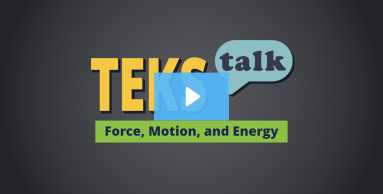- Science
- Grade KG
- Force, motion, and energy
Science.K.7
The student is expected to describe and predict how a magnet interacts with various materials and how magnets can be used to push or pull.

Knowledge and Skills Statement
The following is an example of how to assess proficiency of this student expectation (SE) or a portion of the SE.
Using various materials, have students make predictions about how each material will interact with a magnet. For example, a teacher might ask students to stand up if they predict a magnet will push or pull the material and stay sitting down if they do not predict a magnet will push or pull the material. Have students share their predictions and why they made each prediction. Students should experience how it feels when the magnet interacts with magnetic versus non-magnetic items. Students should also experience how magnets behave with other magnets.
When describing interactions between magnets, students should explain that magnets can push other magnets away and can pull other magnets towards them. When describing interactions between magnets and other objects, students should describe the objects as being pulled towards the magnet or as not being affected by the magnet. After testing the material, have students share their descriptions of what happened. Record predictions and observations for the class to see. Repeat with a variety of materials.
The further explanation is designed to be a resource for educators that helps them better understand the topic their students are learning. Further explanations may be written at a more complex level than would be expected for students at the grade level.
When two objects interact, each one exerts a force on the other. These forces can transfer energy between the objects. Forces between two objects at a distance are explained by force fields (gravitational, electric, or magnetic) between them. In kindergarten, students are not expected to discuss the transfer of energy.
When the forces acting on an object are balanced (are equal in all directions), the motion of the object does not change. When the forces acting on an object are unbalanced (unequal in one or more directions), the motion will change, for example, by changing speed or direction. Students in kindergarten are not expected to use the terms balanced and unbalanced forces.
Magnets will interact with materials that contain iron, nickel, or cobalt (and some other Earth elements). Materials containing these elements will be attracted to a magnet and become temporarily magnetized while in contact with or within the strongest part of the magnetic field of a magnet.
Kindergarten is the only grade in which students will investigate the behavior of magnets. Kindergarten lays the foundation for student understanding of magnets and magnetic fields. Magnetism and the magnetic force will be reinforced in 3rd-5th grade.
Research
Wilcox, Jesse, and Lindsey R. Richey. 2012. “May the Magnetic Force Be With You.” Science and Children 50, no. 2 (October 2012): 62–67. http://www.jstor.org/stable/43176256. Accessed November 22, 2022.
Summary: This article outlines common misconceptions that young students have about magnets and outlines the importance of scaffolding when teaching magnet concepts. Complex ideas about magnets can be difficult for students to comprehend because students cannot see what is happening between a magnet and the object it is attracted to. Students need to know that magnets can attract and repel or push and pull and should be allowed to explore this concept with magnets while teachers ask guiding questions. Allowing students to explore magnets strengthens other important science skills, such as making predictions and categorizing.

